Paid links don’t work. Link relevance is the key factor affecting their value. High DR is the best indication of website authority.
Have you heard any of these before?
There are plenty of link-building myths like the ones above flying around. But are they really myths or is there a grain of truth in them?
In the article, we explore 8 common myths and share our insights based on years of experience building links in the SaaS space.
Myth 1: Paid Links Don’t Work
Paying for backlinks is against search engine guidelines. Their algos are increasingly better at identifying such backlinks. And they ignore them, so they don’t have any impact on your rankings. Or penalize website owners with manual penalties, leading to demoting or even de-indexing the site.
Based on that, one may conclude that paid links don’t work.
However, it’s more complex than this.
92% of the SEOs and link-builders we interviewed for our 2024 State of Link-Building report believe their competitors buy links.

Assuming this is true, what would be the point of them spending their budgets on backlinks that don’t work or can harm their website health?
I suppose it depends a lot on how you define paid links.
Let’s start with links with the rel="sponsored" attributes. That’s how webmasters should mark links that have been paid for. Google treats these along with ‘nofollow’ and ‘ugc’ links as hints and does consider them when ranking pages.
So that’s one legit way to use paid links to improve your SERP performance.
Buying backlinks on Fiverr, from link farms and PBNs is generally frowned upon. While they may give your site a short-term boost, they’re unlikely to bring lasting results.
But what if you work with a reputable link-building agency such as Editorial.Link, that uses white-hat tactics and leverages its networks to secure backlinks from legit sites? You’re still paying for the links but how they’re secured has nothing to do with the shady practices that search engines discourage.
And even if you’re building backlinks in-house using tactics like unlinked brand mentions, guest posting, or link insertions, you usually have to ‘incentivize’ the website owners to add the backlinks. And the incentive is often monetary, especially, for high-quality backlinks.
Myth 2: Only Links From Relevant Websites Count
According to our survey, 84.6% of the experts named relevance as a priority metric when evaluating link quality, and the recent Google API leak confirmed that relevance is one of the key factors.
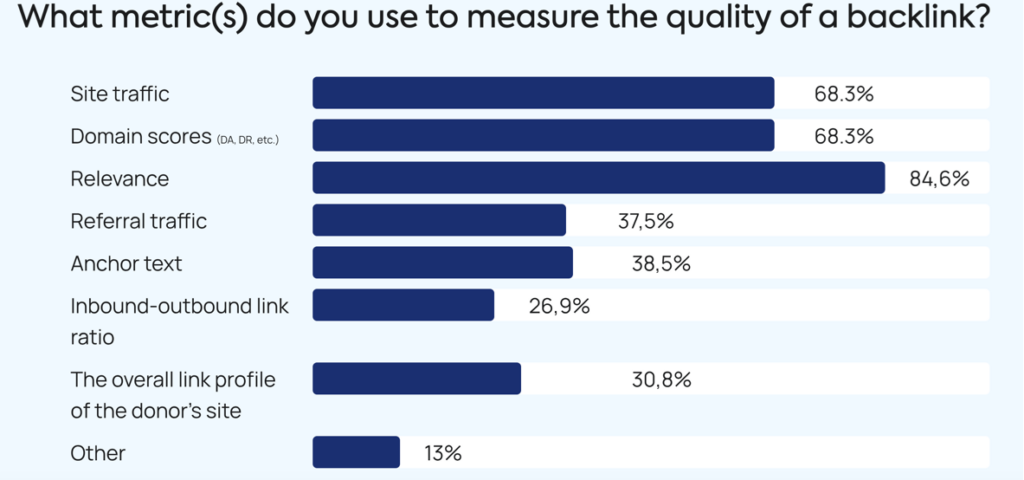
However, this doesn’t mean that backlinks from sites that aren’t related to your niche won’t count.
Take media outlets like the Guardian or New York Times as an example. As they’re not specialized publications, they may not be considered relevant for your niche. And yet, backlinks from such sites are some of the most coveted in SEO and companies pay digital PR agencies lots of $$$ to get them.
Links from high-authority sites can still provide significant SEO benefits, even if they are slightly off-topic. For instance, a link from a major news site can increase your visibility and authority regardless of the niche.
What matters a lot is the relevance of the actual content and anchor text of the backlink.
At this year’s SEO Brighton, Maja Jovanovic, the former Director of SEO at Gaming Innovation Group, gave a talk about how her site’s rankings for all their major keywords suffered after getting backlinks from DR90+ sites like the Guardian or Statista.
The reason?
The anchor texts didn’t match the website’s subject. This skewed Google’s ‘understanding’ of what the content was about.
Myth 3: More Links = Higher Ranking
A recent study by Internet Marketing Ninjas has found that 96% of websites ranking in Google’s top 10 positions have 1000+ backlinks. And only 0.3% of them had fewer than 100 links.
Based on that, it might be tempting to assume that the higher the backlink count, the higher the rankings.
But let’s look at the results a bit closer.
From the table, you can see that the link count seems to matter up to 100k. After this, the impact of backlinks on your chance to rank on the first page declines. So technically, the statement it’s not true. The number of backlinks doesn’t always correlate with a higher ranking.

Moreover, a lot of backlinks don’t necessarily guarantee solid performance in SERPs.
Here’s an example:
With 160K from 12.6K domains, Startup.info has what seems to be an excellent backlink profile. However, the traffic data doesn’t reflect it. If you trust Ahrefs estimates, the site gets only 20 organic visits a month!
This shows that backlinks are just one of the ranking factors and if your content is thin, they won’t help you get more traffic.

It doesn’t stop here.
Our data shows that 300-500 quality links are enough to rank, and for local sites, 30-50 will be enough.
And we have been able to rank in the top 3 for difficult keywords like ‘backlink campaign’ with just a few backlinks.
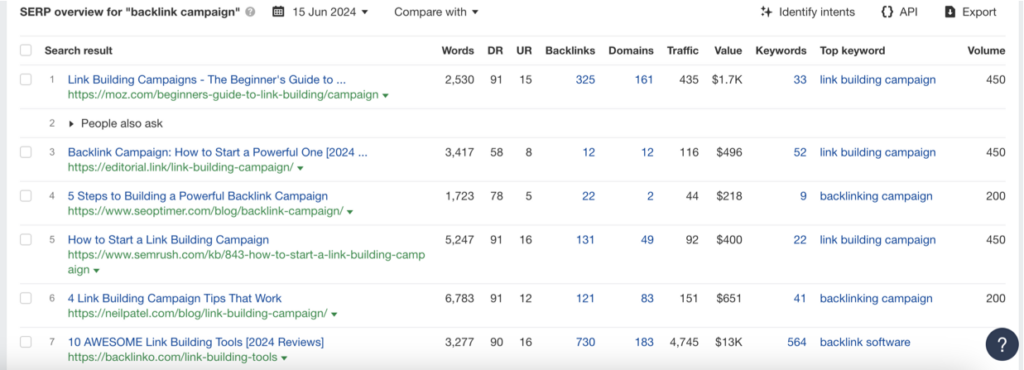
Myth 4: NoFollow Links Don’t Work
I’ve already mentioned nofollow backlinks when I talked about paid links. Just like backlinks with the rel="sponsored" attributes, they are treated by Google as signals and can affect your position in SERPs.
This is a departure from the previous Google policy to simply ignore nofollow backlinks. And that’s where the belief that such backlinks don’t pass any link equity may have started.
It’s not a recent change though. It goes back to 2019.
What’s more, there’s evidence that nofollow backlinks might be as powerful as dofollow ones if they come from relevant authority sites. For example, an experiment by Christopher Panteli and Kyle Roof showed that nofollow backlinks can be considered a ranking factor:
🚨 Our findings clearly suggest that not only do dofollow links have a concrete impact on rankings and can be considered a Google ranking factor, but the quality of nofollow links matters as well.
Apart from the impact on SERPs, nofollow backlinks offer other benefits:
They can increase your brand visibility and bring referral traffic to your website. A nofollow backlink from a website with 100,000 readers may be more beneficial than a dofollow link from a site that hardly anyone visits.
Getting a link from a highly relevant site has the potential to drive relevant leads to your site that are ready-to-buy.
Think of an article discussing drone tech, where users a likely researching before they buy. A link to your drone, recommending it would drive a lot of highly relevant leads to your site who are already in the process of moving down the sales funnel.
A link like this is extremely powerful, even if it’s nofollow.
They also make your backlink profile look natural. When acquired organically, there’s always a mix of dofollow and nofollow backlinks.
So while dofollow backlinks are more attractive than nofollow ones, saying that they don’t work isn’t right.
And SEOs understand it. Nearly 50% of the experts who took part in our study make an effort to secure nofollow backlinks.
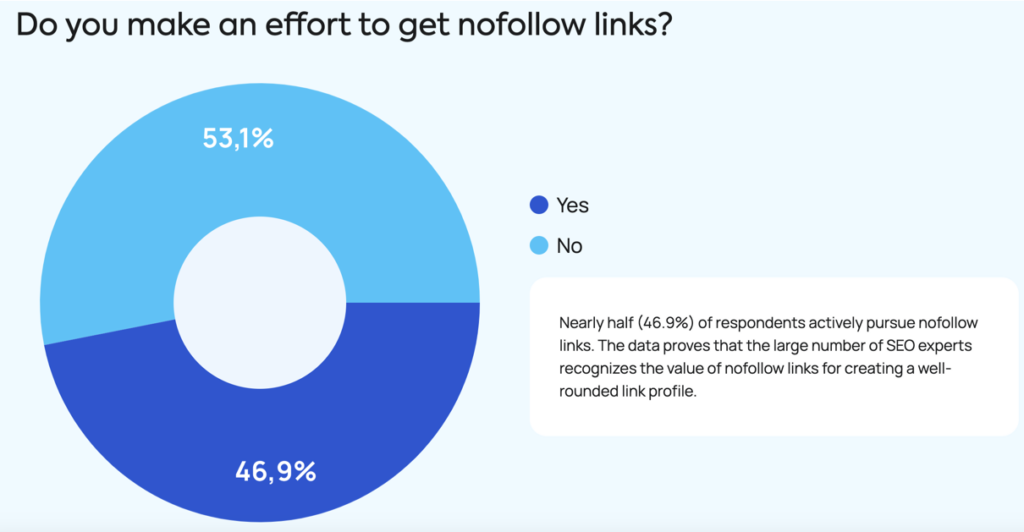
Myth 5: High Domain Rating = Authority Website
69% of our study participants find Domain Rating (DR) the most reliable metric for assessing website authority.
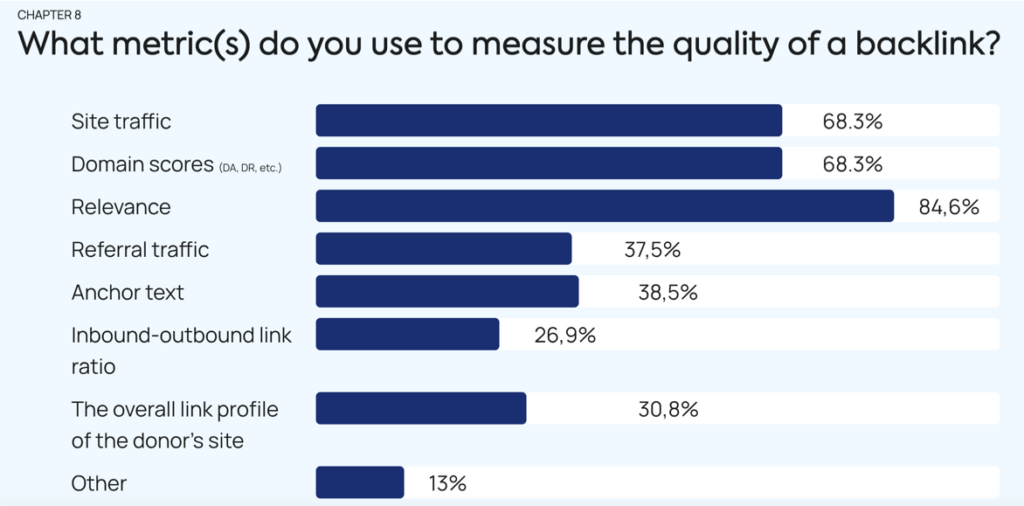
Well, it’s convenient and in many cases, it gives you a good idea of how reputable the website is.
However, DR/DA on its own isn’t enough to determine if you’re dealing with an authority website.
The metric is based on the number of inbound backlinks and the authority of the linking domains. As we saw in the startup.info example above though, it’s possible to have a ‘robust’ backlink profile and yet attract little traffic. In fact, their DR is 76.
I once carried out a quick experiment where I managed to boost the DR of a website to 70 by buying a handful of links on Fiverr. That’s more than the current Editorial.Link rating and yet there was nothing of value on the website.
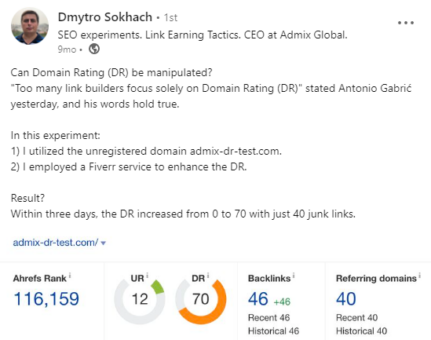
So when assessing the quality of a website, look beyond the DR. Consider its:
- Relevance
- Organic traffic
- Anchor texts
- Branded and referral traffic
- Inbound-outbound link ratio
So this one is definitely a myth.
Myth 6: Writing Great Content Will Get You Links Naturally
If you’re a content writer, a graphic designer, or a video editor, the idea that creating great content is enough to get backlinks organically is very appealing. People recognize the merit of your resources and link to them to add value to their websites.
And lots of SEOs have found this to work. For example, Lauren Walter, Search & Content Director at Online Optimism, has shared an example of a page that earned 270 backlinks in this way:
We’ve found success in producing data-driven link magnets, such as our BeReal stats page, which has attracted over 270 backlinks without any link-building outreach. When BeReal started to gain traction, we collected available data and offered our own insights and observations, creating a valuable resource for journalists writing on the app’s growing popularity.
This might work if you’re already a well-established source with a large following and significant traffic. If not, people won’t be able to find your content, no matter how brilliant it is.
That’s why you need to promote it actively, for example, through outreach or social media campaigns to get it in front of others. And build backlinks to the content to help it rank in SERPs.
Great content alone isn’t enough. Actively promoting and building links is essential. Even excellent content needs visibility. Organic links come easier when content is promoted well. Combining both strategies yields the best results.
Myth 7: Build Links Only for Service/Landing Pages
Even if you’re building backlinks in-house, they are expensive: the research, asset creation, and outreach require time and energy
With limited budgets and human resources, teams often prioritize their service or landing pages because that’s what converts visitors into customers.
However, this isn’t necessarily the best approach for teams with limited resources.
First, building links to money pages only would create a very unnatural link profile. Which could put you into Google’s bad books.
And it isn’t the easiest strategy either.
Backlinks to your BOFU pages are harder to build because it’s often difficult to find relevant content where you can insert such links naturally. Especially, in competitive niches like SaaS this could be a daunting task.
Instead, you can achieve good results by building links to your other pages, like TOFU blog articles, and using internal backlinks to prop up your money pages.
Links to various pages, including blog posts and resource pages, can be valuable. These pages can rank well and drive traffic to your site, indirectly supporting your service/landing pages. For example, a high-ranking blog post can attract visitors who explore your service pages later.
And if you look at the most linked-to pages on the Userpilot website, they’re mostly blog posts. There’s 1 solution page and 1 research report in the top 50, and of course, their homepage.
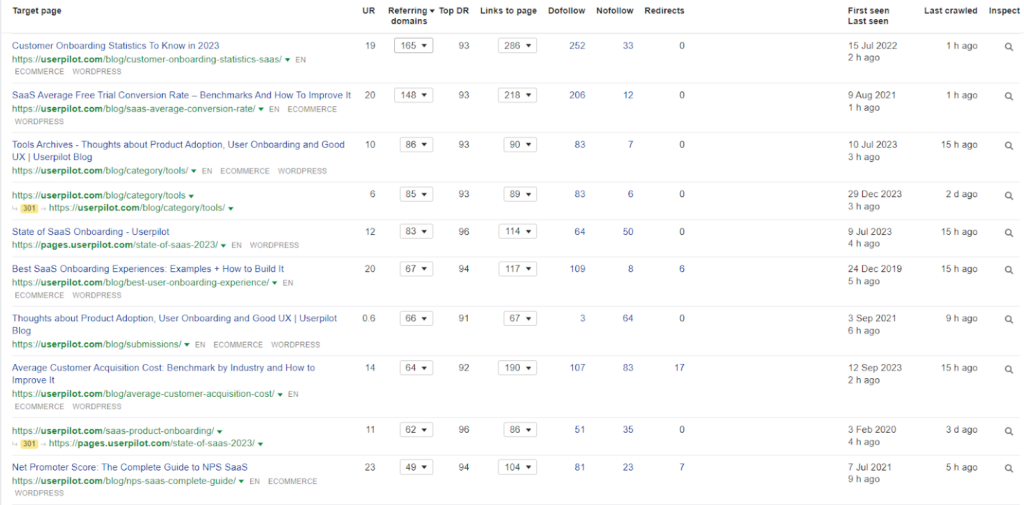
And yet, Userpilot ranks #1 for ‘user onboarding software’.

Each blog post contains a link to a solution page, that’s how they pass their link juice. And they also link to their demo booking page, even if it’s a TOFU article, to drive conversions.

If you want another example of how links can be distributed across different pages, check out the webfx.com backlink profile. In the top 50 most linked-to pages, there’s a link to their homepage as well as their tools and service pages, and blog posts.

Myth 8: Using One Link Building Tactic Is Enough to Rank High
Lots of SEOs rely on one favorite link-building tactic that they find to be most effective. It kind of makes sense: if you’ve got something that clearly works, why bother with other strategies?
However, there are reasons why this may not be the best approach, and using a range of tactics is the prudent thing to do, as Viktoria Medvedko of GetMentioned, points out:
Relying on a single tactic is rarely sufficient. A diverse link-building strategy that includes guest posts, resource links, outreach, and content marketing is more effective. Diversification helps mitigate risks and maximizes opportunities for ranking improvements.
Let’s zoom in on Viktoria’s points, starting with the risks.
For starters, overreliance on one single tactic, say guest posting, creates an unnatural pattern that is easy to spot by search engine algos as an attempt to manipulate rankings.
And as these algos constantly evolve, it may turn out that a particular link type, for example from resource pages, doesn’t offer the same results as they used. If that’s the only link type in your profile, you’re stuffed.
Moving on to the opportunities:
Different link-building tactics offer varied benefits and enable you to reach diverse audiences.
For example, with HARO or by appearing in podcasts, you can establish yourself as a thought leader in your niche, a digital PR campaign can land you a bunch of links from high-authority media sites in a short time, while original evergreen content generates backlinks long after it’s published.
Overall, a comprehensive link-building strategy shouldn’t be based on one single tactic, no matter how effective it is at the moment because doing so is a gamble and may not render sustainable results.
If you want to see a website that leverages a whole host of link-building tactics, including HARO, directory link-building, link insertions, sponsorships, and creating linkable assets, check out LearnWorlds.

Final Words
So here were, 8 popular link-building myths dissected.
Are they really myths though?
Not quite. More like half-truths. For example, the importance of relevance in SEO cannot be overstated even though there are exceptions.
Some of them, like the one about no-follow links, might have been true in the past but algorithm changes have made them obsolete.
And some of them are true in certain situations but not in others. For instance, excellent content may bring backlinks organically for established sites but not for new ones.
At Editorial.Link we recognize the complexity of the SEO landscape. And leverage our expertise to tailor all our link-building campaigns to the unique needs and circumstances of our clients.







